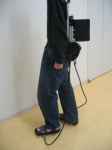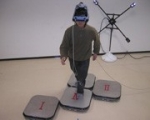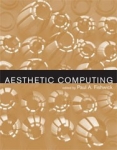May 22, 2006
3rd International Conference on Enactive Interfaces
Via VRoot.org
The 3rd International Conference on Enactive Interfaces, promoted by the European Network of Excellence ENACTIVE INTERFACES, will be held in Montpellier (France) on November 20-21, 2006.
The aim of the conference is to encourage the emergence of a multidisciplinary research community in a new field of research and on a new generation of human-computer interfaces called Enactive Interfaces.
From the website:
Enactive Interfaces are inspired by a fundamental concept of “interaction” that has not been exploited by other approaches to the design of human-computer interface technologies. Mainly, interfaces have been designed to present information via symbols, or icons.
In the symbolic approach, information is stored as words, mathematical symbols or other symbolic systems, while in the iconic approach information is stored in the form of visual images, such as diagrams and illustrations.
ENACTIVE knowledge is information gained through perception-action interactions with the environment. Examples include information gained by grasping an object, by hefting a stone, or by walking around an obstacle that occludes our view. It is gained through intuitive movements, of which we often are not aware. Enactive knowledge is inherently multimodal, because motor actions alter the stimulation of multiple perceptual systems. Enactive knowledge is essential in tasks such as driving a car, dancing, playing a musical instrument, modelling objects from clay, performing sports, and so on.
Enactive knowledge is neither symbolic nor iconic. It is direct, in the sense that it is natural and intuitive, based on experience and the perceptual consequences of motor acts.
ENACTIVE / 06 will highlight convergences between the concept of Enaction and the sciences of complexity. Biological, cognitive, perceptual or technological systems are complex dynamical systems exhibiting (in)stability properties that are consequential for the agent-environment interaction. The conference will provide new insights, through the prism of ENACTIVE COMPLEXITY, about human interaction with multimodal interfaces.
23:15 Posted in Future interfaces | Permalink | Comments (0) | Tags: Positive Technology
Origami Cell Phone
 Via Pasta and Vinegar
Via Pasta and Vinegar The Origami Cell Phone is a future cell phone concept, which uses flexible e-paper to create a larger-than-cell display.
The concept was developed at Inventables, a consulting company specialized in "just about possible" applications.
23:03 Posted in Wearable & mobile | Permalink | Comments (0) | Tags: Positive Technology
The top10 in cognitive science
According to the Cognitive Science Millennium Project, the top 10 most influential works in cognitive science from the 20th century are the following:
- Syntactic Structures Chomsky, N. (1957)
- Vision: a computational investigation into the human representation and processing of visual information Marr, D. (1982)
- Computing machinery and intelligence Turing, A. M. (1950) Mind, 59, 433-460.
- The organization of behavior; a neuropsychological theory Hebb, D.O. (1949)
- Parallel distributed processing: Explorations in the microstructure of cognition Rumelhart, D. E., McClelland, J. L. (1986)
- Human problem solving Newell, A., & Simon, H. A. (1972)
- he modularity of mind: An essay on faculty psychology Fodor, J. (1983)
- Remembering: A study in experimental and social psychology Bartlett, F. C. (1932)
- The magical number seven, plus or minus two: Some limits on our capacity for processing information Miller, G. A. (1956) Psychological Review, 63, 81-97
- Perception and Communication Broadbent, D. (1958)
22:51 | Permalink | Comments (0) | Tags: Positive Technology
Neurotechnology market is raising
The MIT Technology Review has interviewed Zack Lynch, managing directory of market analysis firm NeuroInsights, about the future of neurotechnology. According to a recent report produced by Lynch's firm, 450 companies participate in the neurotechnology market, producing revenues of $110 billion in 2005.
Here is an excerpt of the interview:
Technology Review: Why neurotechnology?Zack Lynch: Neuroscience is now moving from a science to an industry. What we're really looking at is an evolution: researchers are now going beyond basic science and developing more effective therapeutics for brain-related illnesses.
The need is huge. One in four people worldwide suffer from a brain-related illness, which costs a trillion dollars a year in indirect and direct economic costs. We all know someone who is affected. That burden will continue to grow with the aging population. We have more people, and more people living longer -- it's a multiplier effect.
TR: We're also starting to see a new kind of therapy for brain-related illnesses -- electrical stimulation. Various types of stimulation devices are now on the market to treat epilepsy, depression, and Parkinson's disease. What are some of the near- and far-term technologies we'll see with this kind of device?
ZL: We're seeing explosive growth in this area because scientists are overcoming many of the hurdles in this area. One example is longer battery life, so devices don't have to be surgically implanted every five years. Researchers are also developing much smaller devices. Advanced Bionics, for example, has a next-generation stimulator in trials for migraines.
In the neurodevice space, the obesity market is coming on strong. Several companies are working on this, including Medtronics and Leptos Biomedical. In obesity, even a small benefit is a breakthrough, because gastric bypass surgery [one of the most common treatments for morbid obesity] is so invasive.
In the next 10 years, I think we'll start to see a combination of technologies, like maybe a brain stimulator that releases L-dopa [a treatment for Parkinson's disease]. Whether that's viable is a whole other question, but that possibility is there because of the microelectronics revolution.
The real breakthrough will come from work on new electrodes. This will transform neurostimulator applications. With these technologies, you can create noninvasive devices and target very specific parts of the brain. It's like going from a Model T to a Ferrari. Those technologies will present the real competition for drugs.
22:42 Posted in Neurotechnology & neuroinformatics | Permalink | Comments (0) | Tags: Positive Technology
May 21, 2006
Foundation and Practice of Neurofeedback for the Treatment of Epilepsy
Appl Psychophysiol Biofeedback. 2006 Apr 14;
Authors: Sterman MB, Egner T
This review provides an updated overview of the neurophysiological rationale, basic and clinical research literature, and current methods of practice pertaining to clinical neurofeedback. It is based on documented findings, rational theory, and the research and clinical experience of the authors. While considering general issues of physiology, learning principles, and methodology, it focuses on the treatment of epilepsy with sensorimotor rhythm (SMR) training, arguably the best established clinical application of EEG operant conditioning. The basic research literature provides ample data to support a very detailed model of the neural generation of SMR, as well as the most likely candidate mechanism underlying its efficacy in clinical treatment. Further, while more controlled clinical trials would be desirable, a respectable literature supports the clinical utility of this alternative treatment for epilepsy. However, the skilled practice of clinical neurofeedback requires a solid understanding of the neurophysiology underlying EEG oscillation, operant learning principles and mechanisms, as well as an in-depth appreciation of the ins and outs of the various hardware/software equipment options open to the practitioner. It is suggested that the best clinical practice includes the systematic mapping of quantitative multi-electrode EEG measures against a normative database before and after treatment to guide the choice of treatment strategy and document progress towards EEG normalization. We conclude that the research literature reviewed in this article justifies the assertion that neurofeedback treatment of epilepsy/seizure disorders constitutes a well-founded and viable alternative to anticonvulsant pharmacotherapy.
23:51 Posted in Biofeedback & neurofeedback | Permalink | Comments (0) | Tags: Positive Technology
Towards adaptive classification for BCI
Towards adaptive classification for BCI.
J Neural Eng. 2006 Mar;3(1):R13-23
Authors: Shenoy P, Krauledat M, Blankertz B, Rao RP, Müller KR
Non-stationarities are ubiquitous in EEG signals. They are especially apparent in the use of EEG-based brain-computer interfaces (BCIs): (a) in the differences between the initial calibration measurement and the online operation of a BCI, or (b) caused by changes in the subject's brain processes during an experiment (e.g. due to fatigue, change of task involvement, etc). In this paper, we quantify for the first time such systematic evidence of statistical differences in data recorded during offline and online sessions. Furthermore, we propose novel techniques of investigating and visualizing data distributions, which are particularly useful for the analysis of (non-)stationarities. Our study shows that the brain signals used for control can change substantially from the offline calibration sessions to online control, and also within a single session. In addition to this general characterization of the signals, we propose several adaptive classification schemes and study their performance on data recorded during online experiments. An encouraging result of our study is that surprisingly simple adaptive methods in combination with an offline feature selection scheme can significantly increase BCI performance.
23:50 Posted in Brain-computer interface | Permalink | Comments (0) | Tags: Positive Technology
Towards adaptive classification for BCI
Towards adaptive classification for BCI.
J Neural Eng. 2006 Mar;3(1):R13-23
Authors: Shenoy P, Krauledat M, Blankertz B, Rao RP, Müller KR
Non-stationarities are ubiquitous in EEG signals. They are especially apparent in the use of EEG-based brain-computer interfaces (BCIs): (a) in the differences between the initial calibration measurement and the online operation of a BCI, or (b) caused by changes in the subject's brain processes during an experiment (e.g. due to fatigue, change of task involvement, etc). In this paper, we quantify for the first time such systematic evidence of statistical differences in data recorded during offline and online sessions. Furthermore, we propose novel techniques of investigating and visualizing data distributions, which are particularly useful for the analysis of (non-)stationarities. Our study shows that the brain signals used for control can change substantially from the offline calibration sessions to online control, and also within a single session. In addition to this general characterization of the signals, we propose several adaptive classification schemes and study their performance on data recorded during online experiments. An encouraging result of our study is that surprisingly simple adaptive methods in combination with an offline feature selection scheme can significantly increase BCI performance.
23:49 Posted in Brain-computer interface | Permalink | Comments (0) | Tags: Positive Technology
May 20, 2006
The NEW TIES project
Via Cognews
With funding from the European Commission's Future and Emerging Technologies (FET) initiative of the IST programme, five European research institutes are collaborating on the NEW TIES project to create a thoroughly 21st-century brave new world - one populated by randomly generated software beings, capable of developing their own language and culture.
From the project's website
The project is concerned with emergence and complexity in socially-inspired artificial systems. We will study large systems consisting of an environment and an inhabitant population. The main goal of the project is to realize an evolving artificial society capable of exploring the environment and developing its own image of this environment and the society through cooperation and interaction. We will work with virtual grid worlds and will set up environments that are sufficiently complex and demanding that communication and cooperation are necessary to adapt to the given tasks. The population's weaponry to develop advanced skills bottom-up consists of individual learning, evolutionary learning, and social learning. One of the main innovations of this project is social learning interpreted as passing knowledge explicitly via a language to others in the same generation. This has a synergetic effect on the learning processes and enables the society to rapidly develop an "understanding" of the world collectively. If the learning process stabilises, the collective must have formed an appropriate world map. Then we will probe the collective mind to learn how the agents perceive the environment, including themselves, and what skills and procedures they have developed to adapt successfully. This could yield new knowledge and surprising perspectives about the environment and the survival task. The project represents a significant scale-up beyond the state-of-the-art in two dimensions: the inner complexity of inhabitants and the size of the population. To achieve and explore highly complex organisms and behaviours, very large populations will be studied. This will make the system at the macro level complex enough to allow significant behaviours (cultures etc) to emerge in separate parts of the system and to interact. To enable this we will set up a large distributed computing infrastructure, and a shared platform to allow very large scale experiments in a p2p fashion.
12:57 Posted in AI & robotics | Permalink | Comments (0) | Tags: Positive Technology
May 18, 2006
Special issue of CyberPsychology & Behavior on Virtual Rehabilitation

CyberPsychology & Behavior
Volume 9, Number 2, Apr 2006
------------------------------------------------------------------------
The above issue is now available online from Liebert Online at:
http://www.liebertonline.com/toc/cpb/9/2
The table of contents for this issue is listed below. Click on the links below to view the abstract for each article, or click on the link above to read the table of contents online.
------------------------------------------------------------------------
State of the Art in Virtual Rehabilitation
Albert "Skip" Rizzo
CyberPsychology & Behavior, Vol. 9, No. 2: 113-113.
http://www.liebertonline.com/doi/abs/10.1089/cpb.2006.9.113
------------------------------------------------------------------------
TIES that BIND: An Introduction to Domain Mapping as a Visualization Tool for Virtual Rehabilitation
Patrice L. (Tamar) Weiss, Rochelle Kedar, Meir Shahar CyberPsychology & Behavior, Vol. 9, No. 2: 114-122.
http://www.liebertonline.com/doi/abs/10.1089/cpb.2006.9.114
------------------------------------------------------------------------
Feasibility, Motivation, and Selective Motor Control: Virtual Reality Compared to Conventional Home Exercise in Children with Cerebral Palsy
C. Bryanton, J. Bosse, M. Brien, J. Mclean, A. McCormick, H. Sveistrup
CyberPsychology & Behavior, Vol. 9, No. 2: 123-128.
http://www.liebertonline.com/doi/abs/10.1089/cpb.2006.9.123
------------------------------------------------------------------------
Integrating Haptic-Tactile Feedback into a Video-Capture-Based Virtual Environment for Rehabilitation
Uri Feintuch, Liat Raz, Jane Hwang, Naomi Josman, Noomi Katz, Rachel Kizony, Debbie Rand, Albert "Skip" Rizzo, Meir Shahar, Jang Yongseok, Patrice L. (Tamar) Weiss
CyberPsychology & Behavior, Vol. 9, No. 2: 129-132.
http://www.liebertonline.com/doi/abs/10.1089/cpb.2006.9.129
------------------------------------------------------------------------
Reaching within Video-Capture Virtual Reality: Using Virtual Reality as a Motor Control Paradigm
Assaf Y. Dvorkin, Meir Shahar, Patrice L. (Tamar) Weiss
CyberPsychology & Behavior, Vol. 9, No. 2: 133-136.
http://www.liebertonline.com/doi/abs/10.1089/cpb.2006.9.133
------------------------------------------------------------------------
Virtual Reality in the Rehabilitation of the Upper Limb after Stroke: The User?s Perspective
J.H. Crosbie, S. Lennon, M.D.J. McNeill, S.M. McDonough
CyberPsychology & Behavior, Vol. 9, No. 2: 137-141.
http://www.liebertonline.com/doi/abs/10.1089/cpb.2006.9.137
------------------------------------------------------------------------
Usability of the Remote Console for Virtual Reality Telerehabilitation: Formative Evaluation
Jeffrey A. Lewis, Judith E. Deutsch, Grigore Burdea
CyberPsychology & Behavior, Vol. 9, No. 2: 142-147.
http://www.liebertonline.com/doi/abs/10.1089/cpb.2006.9.142
------------------------------------------------------------------------
The Rutgers Arm, a Rehabilitation System in Virtual Reality: A Pilot Study
Manjuladevi Kuttuva, Rares Boian, Alma Merians, Grigore Burdea, Mourad Bouzit, Jeffrey Lewis, Devin Fensterheim
CyberPsychology & Behavior, Vol. 9, No. 2: 148-152.
http://www.liebertonline.com/doi/abs/10.1089/cpb.2006.9.148
------------------------------------------------------------------------
Responses to a Virtual Reality Grocery Store in Persons with and without Vestibular Dysfunction
Susan L. Whitney, Patrick J. Sparto, Larry F. Hodges, Sabarish V. Babu, Joseph M. Furman, Mark S. Redfern
CyberPsychology & Behavior, Vol. 9, No. 2: 152-156.
http://www.liebertonline.com/doi/abs/10.1089/cpb.2006.9.152
------------------------------------------------------------------------
A Treadmill and Motion Coupled Virtual Reality System for Gait Training Post-Stroke
Joyce Fung, Carol L. Richards, Francine Malouin, Bradford J. McFadyen, Anouk Lamontagne
CyberPsychology & Behavior, Vol. 9, No. 2: 157-162.
http://www.liebertonline.com/doi/abs/10.1089/cpb.2006.9.157
------------------------------------------------------------------------
Influences of the Perception of Self-Motion on Postural Parameters
E.A. Keshner, K. Dokka, R.V. Kenyon
CyberPsychology & Behavior, Vol. 9, No. 2: 163-166.
http://www.liebertonline.com/doi/abs/10.1089/cpb.2006.9.163
------------------------------------------------------------------------
Immersive Virtual Reality as a Rehabilitative Technology for Phantom Limb Experience: A Protocol
Craig D. Murray, Emma Patchick, Stephen Pettifer, Fabrice Caillette, Toby Howard
CyberPsychology & Behavior, Vol. 9, No. 2: 167-170.
http://www.liebertonline.com/doi/abs/10.1089/cpb.2006.9.167
------------------------------------------------------------------------
Motor Training in the Manipulation of Flexible Objects in Haptic Environments
I. Goncharenko, M. Svinin, Y. Kanou, S. Hosoe
CyberPsychology & Behavior, Vol. 9, No. 2: 171-174.
http://www.liebertonline.com/doi/abs/10.1089/cpb.2006.9.171
------------------------------------------------------------------------
Using Virtual Environment to Improve Spatial Perception by People Who Are Blind
Orly Lahav
CyberPsychology & Behavior, Vol. 9, No. 2: 174-177.
http://www.liebertonline.com/doi/abs/10.1089/cpb.2006.9.174
------------------------------------------------------------------------
The Jerusalem TeleRehabilitation System, a New Low-Cost, Haptic Rehabilitation Approach
Heidi Sugarman, Ehud Dayan, Aviva Weisel-Eichler, Joseph Tiran
CyberPsychology & Behavior, Vol. 9, No. 2: 178-182.
http://www.liebertonline.com/doi/abs/10.1089/cpb.2006.9.178
------------------------------------------------------------------------
Human Experience Modeler: Context-Driven Cognitive Retraining to Facilitate Transfer of Learning
C.M. Fidopiastis, C.B. Stapleton, J.D. Whiteside, C.E. Hughes, S.M. Fiore, G.A. Martin, J.P. Rolland, E.M. Smith
CyberPsychology & Behavior, Vol. 9, No. 2: 183-187.
http://www.liebertonline.com/doi/abs/10.1089/cpb.2006.9.183
------------------------------------------------------------------------
Application of Virtual Reality Graphics in Assessment of Concussion
Semyon Slobounov, Elena Slobounov, Karl Newell
CyberPsychology & Behavior, Vol. 9, No. 2: 188-191.
http://www.liebertonline.com/doi/abs/10.1089/cpb.2006.9.188
------------------------------------------------------------------------
Virtual Reality Pencil and Paper Tests for Neglect: AProtocol
Kenji Baheux, Makoto Yoshizawa, Kazunori Seki, Yasunobu Handa
CyberPsychology & Behavior, Vol. 9, No. 2: 192-195.
http://www.liebertonline.com/doi/abs/10.1089/cpb.2006.9.192
------------------------------------------------------------------------
Virtual and Physical Toys: Open-Ended Features for Non-Formal Learning
Eva Petersson, Anthony Brooks
CyberPsychology & Behavior, Vol. 9, No. 2: 196-199.
http://www.liebertonline.com/doi/abs/10.1089/cpb.2006.9.196
------------------------------------------------------------------------
Three-Dimensional Virtual Environments for Blind Children
Jaime Sanchez, Mauricio Saenz
CyberPsychology & Behavior, Vol. 9, No. 2: 200-206.
http://www.liebertonline.com/doi/abs/10.1089/cpb.2006.9.200
------------------------------------------------------------------------
Effectiveness of Virtual Reality for Pediatric Pain Distraction during IV Placement
Jeffrey I. Gold, Seok Hyeon Kim, Alexis J. Kant, Michael H. Joseph, Albert "Skip" Rizzo
CyberPsychology & Behavior, Vol. 9, No. 2: 207-212.
http://www.liebertonline.com/doi/abs/10.1089/cpb.2006.9.207
------------------------------------------------------------------------
Simulating Social Interaction to Address Deficits of Autistic Spectrum Disorder in Children
Cheryl Y. Trepagnier, Marc M. Sebrechts, Andreas Finkelmeyer, Willie Stewart, Jordana Woodford, Maya Coleman
CyberPsychology & Behavior, Vol. 9, No. 2: 213-217.
http://www.liebertonline.com/doi/abs/10.1089/cpb.2006.9.213
------------------------------------------------------------------------
Starting Research in Interaction Design with Visuals for Low-Functioning Children in the Autistic Spectrum: A Protocol
Narcis Pares, Anna Carreras, Jaume Durany, Jaume Ferrer, Pere Freixa, David Gomez, Orit Kruglanski, Roc Pares, J. Ignasi Ribas, Miquel Soler, Alex Sanjurjo
CyberPsychology & Behavior, Vol. 9, No. 2: 218-223.
http://www.liebertonline.com/doi/abs/10.1089/cpb.2006.9.218
------------------------------------------------------------------------
Virtual Reality Assessment of Medication Compliance in Patients with Schizophrenia
Elizabeth K. Baker, Matthew M. Kurtz, Robert S. Astur
CyberPsychology & Behavior, Vol. 9, No. 2: 224-229.
http://www.liebertonline.com/doi/abs/10.1089/cpb.2006.9.224
------------------------------------------------------------------------
Reality Check: The Role of Realism in Stress Reduction Using Media Technology
Y.A.W. de Kort, W.A. Ijsselsteijn
CyberPsychology & Behavior, Vol. 9, No. 2: 230-233.
http://www.liebertonline.com/doi/abs/10.1089/cpb.2006.9.230
------------------------------------------------------------------------
Hippocampus Function Predicts Severity of Post-Traumatic Stress Disorder
Robert S. Astur, Sarah A. St. Germain, David Tolin, Julian Ford, David Russell, Mike Stevens
CyberPsychology & Behavior, Vol. 9, No. 2: 234-240.
http://www.liebertonline.com/doi/abs/10.1089/cpb.2006.9.234
------------------------------------------------------------------------
BusWorld: Designing a Virtual Environment for Post-Traumatic Stress Disorder in Israel: A Protocol
Naomi Josman, Eli Somer, Ayelet Reisberg, Patrice L. (Tamar) Weiss, Azucena Garcia-Palacios, Hunter Hoffman
CyberPsychology & Behavior, Vol. 9, No. 2: 241-244.
http://www.liebertonline.com/doi/abs/10.1089/cpb.2006.9.241
------------------------------------------------------------------------
Simulation and Virtual Reality in Medical Education and Therapy: A Protocol
Michael J. Roy, Deborah L. Sticha, Patricia L. Kraus, Dale E. Olsen
CyberPsychology & Behavior, Vol. 9, No. 2: 245-247.
http://www.liebertonline.com/doi/abs/10.1089/cpb.2006.9.245
------------------------------------------------------------------------
Virtual Reality Applications to Agoraphobia: A Protocol
Georgina Cardenas, Sandra Munoz, Maribel Gonzalez, Guillermo Uribarren
CyberPsychology & Behavior, Vol. 9, No. 2: 248-250.
http://www.liebertonline.com/doi/abs/10.1089/cpb.2006.9.248
------------------------------------------------------------------------
CyberSightings
Albert "Skip" Rizzo
CyberPsychology & Behavior, Vol. 9, No. 2: 251-257.
http://www.liebertonline.com/doi/abs/10.1089/cpb.2006.9.251
------------------------------------------------------------------------
CyberEurope
Giuseppe Riva, Alessandra Preziosa
CyberPsychology & Behavior, Vol. 9, No. 2: 258-260.
http://www.liebertonline.com/doi/abs/10.1089/cpb.2006.9.258
15:50 Posted in Cybertherapy | Permalink | Comments (0) | Tags: Positive Technology
Impaired allocentric spatial memory underlying topographical disorientation
Impaired allocentric spatial memory underlying topographical disorientation.
Rev Neurosci. 2006;17(1-2):239-51
Authors: Burgess N, Trinkler I, King J, Kennedy A, Cipolotti L
The cognitive processes supporting spatial navigation are considered in the context of a patient (CF) with possible very early Alzheimer's disease who presents with topographical disorientation. Her verbal memory and her recognition memory for unknown buildings, landmarks and outdoor scenes was intact, although she showed an impairment in face processing. By contrast, her navigational ability, quantitatively assessed within a small virtual reality (VR) town, was significantly impaired. Interestingly, she showed a selective impairment in a VR object-location memory test whenever her viewpoint was shifted between presentation and test, but not when tested from the same viewpoint. We suggest that a specific impairment in locating objects relative to the environment rather than relative to the perceived viewpoint (i.e. allocentric rather than egocentric spatial memory) underlies her topographical disorientation. We discuss the likely neural bases of this deficit in the light of related studies in humans and animals, focusing on the hippocampus and related areas. The specificity of our test indicates a new way of assessing topographical disorientation, with possible application to the assessment of progressive dementias such as Alzheimer's disease.
15:46 Posted in Virtual worlds | Permalink | Comments (0) | Tags: Positive Technology
May 17, 2006
Robot of the year award
Via Pink Tentacle (source: Yomiuri Shimbun)
The Ministry of Economy, Trade and Industry (METI) plans to establish an annual Robot of the Year Award to recognize outstanding robots developed and put into practical use each year. In addition to the grand prize, prizes will be awarded to robots in the following categories: (1) industrial robots, such as those used in painting and welding, (2) service robots, such as those used in cleaning and security, (3) robots for use in special environments, such as rescue robots, and (4) robots developed by small to medium sized venture firms.
19:43 Posted in AI & robotics | Permalink | Comments (0) | Tags: Positive Technology
Air display
The company IO2 has developed a new display technology, the Heliodisplay, which allows to project into the air still or moving images that can be manipulated with a fingertip. The Heliodisplay works by creating a cloud of microscopic particles that make the air a display medium.
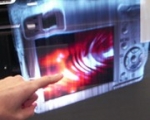
From the company's website:
Heliodisplay images are not holographic although they are free-space, employing a rear projection system in which images are captured onto a nearly invisible plane of transformed air. What the viewer sees is floating mid-air image or video. These projected images and video are two-dimensional space (i.e. planar) but appear 3D since there is no physical depth reference. While conventional displays have the benefit of being attached to a physical substrate, Heliodisplay projections are located in air, so you will notice some waviness to the quality of Heliodisplay images.
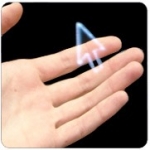
Watch the video here
19:22 Posted in Virtual worlds | Permalink | Comments (0) | Tags: Positive Technology
May 16, 2006
Building a Playground of Light
Via Wired

Innovations from NYU's technology program include a digital projector that turns the walls and floor of a therapist's office into an interactive game space. The goal: keeps kids engaged.
Read the full story
10:25 Posted in Cybertherapy | Permalink | Comments (0) | Tags: Positive Technology
May 15, 2006
Daegu to Launch 'Ubiquitous' Health Monitoring
From Smart Mobs
Daegu in South Korea "will be the first city in the country to provide a “ubiquitous” healthcare service in which so-called wearable computers will be used to monitor the health of elderly people living alone and patients with chronic diseases,"this article says."The devices,in the form of shirts,alert medical staff in real time when an emergency occurs.Daegu City said Thursday that it will launch its groundbreaking “U-Healthcare Service” in cooperation with the Ministry of Information and Communication.The city will distribute the bio-shirts to some 100 elderly people and patients with chronic diseases later this year.The shirts have embedded sensors that register vital signs and send the information to medical centers through the network. They also permit self-diagnosis, distance monitoring, emergency care and medical consultation for users in an environment of ubiquitous connectivity"
Daegu to Launch 'Ubiquitous' Health Monitoring
22:22 Posted in Wearable & mobile | Permalink | Comments (0) | Tags: Positive Technology
Powered Shoes
It has often been suggested that the best locomotion mechanism for virtual worlds would be walking, and it is well known that the sense of distance or orientation while walking is much better than while riding in a vehicle. However, the proprioceptive feedback of walking is not provided in most virtual environments. Powered Shoes is a revolutionary advance for entertainment and simulation applications, because it provides this proprioceptive feedback.
CirculaFloor is a locomotion interface using a group of movable floors. The movable floors employ a holonomic mechanism that achieves omni-directional motion. Circulation of the floors enables users to walk in arbitrary directions in a virtual environment while their positions are maintained
22:05 Posted in Virtual worlds | Permalink | Comments (0) | Tags: Positive Technology
Group Cognition

Innovative uses of global and local networks of linked computers make new ways of collaborative working, learning, and acting possible. In Group Cognition Gerry Stahl explores the technological and social reconfigurations that are needed to achieve computer-supported collaborative knowledge building--group cognition that transcends the limits of individual cognition. Computers can provide active media for social group cognition where ideas grow through the interactions within groups of people; software functionality can manage group discourse that results in shared understandings, new meanings, and collaborative learning. Stahl offers software design prototypes, analyzes empirical instances of collaboration, and elaborates a theory of collaboration that takes the group, rather than the individual, as the unit of analysis.
Stahl's design studies concentrate on mechanisms to support group formation, multiple interpretive perspectives, and the negotiation of group knowledge in applications as varied as collaborative curriculum development by teachers, writing summaries by students, and designing space voyages by NASA engineers. His empirical analysis shows how, in small-group collaborations, the group constructs intersubjective knowledge that emerges from and appears in the discourse itself. This discovery of group meaning becomes the springboard for Stahl's outline of a social theory of collaborative knowing. Stahl also discusses such related issues as the distinction between meaning making at the group level and interpretation at the individual level, appropriate research methodology, philosophical directions for group cognition theory, and suggestions for further empirical work.
21:50 Posted in Social Media | Permalink | Comments (0) | Tags: Positive Technology
Aesthetic Computing
From Amazon
In Aesthetic Computing, key scholars and practitioners from art, design, computer science, and mathematics lay the foundations for a discipline that applies the theory and practice of art to computing. Aesthetic computing explores the way art and aesthetics can play a role in different areas of computer science. One of its goals is to modify computer science by the application of the wide range of definitions and categories normally associated with making art. For example, structures in computing might be represented using the style of Gaudi or the Bauhaus school. This goes beyond the usual definition of aesthetics in computing, which most often refers to the formal, abstract qualities of such structures--a beautiful proof, or an elegant diagram. The contributors to this book discuss the broader spectrum of aesthetics--from abstract qualities of symmetry and form to ideas of creative expression and pleasure--in the context of computer science. The assumption behind aesthetic computing is that the field of computing will be enriched if it embraces all of aesthetics. Human-computer interaction will benefit--"usability," for example, could refer to improving a user's emotional state--and new models of learning will emerge.
Aesthetic Computing approaches its subject from a variety of perspectives. After defining the field and placing it in its historical context, the book looks at art and design, mathematics and computing, and interface and interaction. Contributions range from essays on the art of visualization and "the poesy of programming" to discussions of the aesthetics of mathematics throughout history and transparency and reflectivity in interface design.
21:45 Posted in Emotional computing | Permalink | Comments (0) | Tags: Positive Technology
May 14, 2006
South Korea develops next wave of virtual reality goggles
Via VRoot
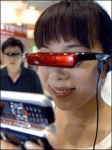
Kowon Technology said the product would provide consumers with crystal clear video images alongside high-quality audio sounds that would be enjoyed privately through two liquid crystal display panels (LCD).
Read the full story on Yahoo! News
14:45 Posted in Virtual worlds | Permalink | Comments (0) | Tags: Positive Technology
Neurotech-art
Re-blogged from: Neurofuture
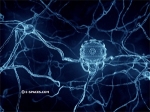
Philippe Van Nedervelde's E-spaces 3D Art Studio created Nanobots replacing neurons (nerve cells). This a still image of HD animation, depicting robots in the brain, from the transhumanist documentary Beyond Man (2005).
Although imaginary, current developments like MIT's nano neuro knitting experiment in which peptide nanofiber scaffolding was used to repair brain tissue in a hamster (article in PNAS) make it prescient.
Van Nedervelde's art is part of NANO, a virtual exhibit curated by transhumanist visionary Natasha Vita-More to showcase nanotech art by artists from a number of disciplines, including the multitalented Anders Sandberg. He's a computational neuroscientist and research associate at Oxford's Future of Humanity Institute.
Listen to a recent interview on the subject with Natasha Vita-More by RU Sirius from The MondoGlobo Network, as well as a podcast called Global Design and Nanotechnology from the (podcast archive alert!) Futures Podcast on Culture and Technology series.
14:40 Posted in Cyberart | Permalink | Comments (0) | Tags: Positive Technology
May 13, 2006
Spontaneous mentalizing during an interactive real world task: An fMRI study
Spontaneous mentalizing during an interactive real world task: An fMRI study.
Neuropsychologia. 2006 May 8;
Authors: Spiers HJ, Maguire EA
There are moments in everyday life when we need to consider the thoughts and intentions of other individuals in order to act in a socially appropriate manner. Most of this mentalizing occurs spontaneously as we go about our business in the complexity of the real world. As such, studying the neural basis of spontaneous mentalizing has been virtually impossible. Here we devised a means to achieve this by employing a unique combination of functional magnetic resonance imaging (fMRI), a detailed and interactive virtual reality simulation of a bustling familiar city, and a retrospective verbal report protocol. We were able to provide insights into the content of spontaneous mentalizing events and identify the brain regions that underlie them. We found increased activity in a number of regions, namely the right posterior superior temporal sulcus, the medial prefrontal cortex and the right temporal pole associated with spontaneous mentalizing. Furthermore, we observed the right posterior superior temporal sulcus to be consistently active during several different subtypes of mentalizing events. By contrast, medial prefrontal cortex seemed to be particularly involved in thinking about agents that were visible in the environment. Our findings show that it is possible to investigate the neural basis of mentalizing in a manner closer to its true context, the real world, opening up intriguing possibilities for making comparisons with those who have mentalizing problems.
20:07 Posted in Virtual worlds | Permalink | Comments (0) | Tags: Positive Technology







